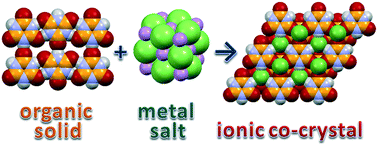Organic–inorganic ionic co-crystals: a new class of multipurpose compounds
Abstract
In this highlight, the reasons for the widespread interest generated by ionic co-crystals, namely those formed by a neutral molecule and a salt, are addressed. In particular, the class of compounds obtained by co-crystallization of neutral organic molecules and inorganic salts (e.g. alkali and alkaline earth halides, sulfates, phosphates etc.) is discussed with the focus on their applications in diverse areas, such as pharmaceuticals, food and fertilizers, and also in chiral resolution. It is argued that, in terms of structure and intermolecular bonding features, these compounds do not differ from classical coordination compounds (complexes) and that their popularity arises from the effectiveness of the organic–inorganic assembly to enhance thermal stability, improve particle size and morphology and change significantly the solubility and dissolution rate with respect to those of the pure active ingredients.

- This article is part of the themed collections: CrystEngComm 20th volume collection and 2018 Highlight article collection


 Please wait while we load your content...
Please wait while we load your content...